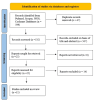Effects of Yoga on Gene Expression: A Systematic Review of Randomised Controlled Trials
- PMID: 40400827
- PMCID: PMC12094062
- DOI: 10.7759/cureus.82690
Effects of Yoga on Gene Expression: A Systematic Review of Randomised Controlled Trials
Abstract
Yoga, an integrative mind-body practice, is increasingly recognised for its ability to modulate gene expression, particularly that of genes associated with inflammation, stress, and aging. This systematic review, conducted per the Preferred Reporting Items for Systematic Reviews and Meta-Analyses (PRISMA) guidelines, synthesises evidence from 11 randomised controlled trials (RCTs) from 2015 to 2024, involving over 700 adults. Studies were sourced from PubMed, Scopus, Web of Science, and the Cochrane Library to evaluate the molecular effects and clinical implications of yoga. Across these RCTs, yoga consistently downregulated pro-inflammatory genes - interleukin-6 (IL-6), tumour necrosis factor-alpha (TNF-α), and nuclear factor kappa B (NF-κB) - in five studies, and upregulated anti-inflammatory and immune-regulatory genes - transforming growth factor-beta (TGF-β), forkhead box P3 (FoxP3), soluble human leukocyte antigen G (sHLA-G), and IL-10 - in four studies. It also enhanced the expression of genes linked to deoxyribonucleic acid (DNA) repair (OGG1, or 8-oxoguanine DNA glycosylase), mitochondrial function (adenosine monophosphate-activated protein kinase (AMPK), and sirtuin 1 (SIRT-1)), and epigenetic regulation (e.g., reduced TNF methylation and increased microRNA-133B (miR-133B)). These molecular changes were associated with clinical benefits, including reduced disease activity in rheumatoid arthritis (RA), improved glycemic control in type 2 diabetes (T2D), and improved quality of life among breast cancer survivors. Despite these promising findings, the small sample sizes and short intervention durations limit statistical power and generalisability. Yoga shows potential as a complementary therapy for managing inflammation and age-related conditions, but larger, longer-term RCTs with standardised protocols are essential to substantiate its therapeutic value and elucidate its mechanisms.
Keywords: epigenetics; gene expression; inflammation; telomeres; yoga.
Copyright © 2025, Giridharan et al.
Conflict of interest statement
Conflicts of interest: In compliance with the ICMJE uniform disclosure form, all authors declare the following: Payment/services info: All authors have declared that no financial support was received from any organization for the submitted work. Financial relationships: All authors have declared that they have no financial relationships at present or within the previous three years with any organizations that might have an interest in the submitted work. Other relationships: All authors have declared that there are no other relationships or activities that could appear to have influenced the submitted work.
Figures
References
-
- Basavaraddi IV. Yoga: its origin, history and development. [ Mar; 2025 ]. 2025. https://rijmri.com/wp-content/uploads/2023/01/Yoga.pdf https://rijmri.com/wp-content/uploads/2023/01/Yoga.pdf
-
- Feuerstein G. Shambhala Publications; 2011. The Path of Yoga: An Essential Guide to Its Principles and Practices.
-
- Swami vivekananda's concept of jnana yoga, raja yoga, karma yoga and bhakti yoga. Yogeshwar G. https://www.researchgate.net/publication/224897898_Swami_vivekananda's_c.... Anc Sci Life. 1994;13:261–265. - PMC - PubMed
-
- Why yoga? An introduction to philosophy, practice, and the role of yoga in health promotion and disease prevention. Chapman K, Bredin S. https://doi.org/10.14288/hfjc.v3i2.54 Health Fit J Can. 2011;3:54.
Publication types
LinkOut - more resources
Full Text Sources
Research Materials


